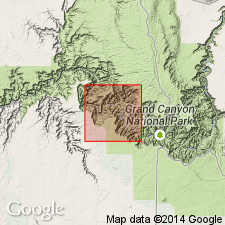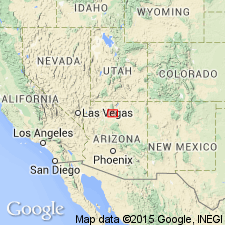
- Usage in publication:
-
- Hotauta conglomerate*
- Modifications:
-
- Original reference
- Dominant lithology:
-
- Conglomerate
- AAPG geologic province:
-
- Southern Rocky Mountain region
Summary:
Hotauta conglomerate of Unkar group of Grand Canyon series. Arkose conglomerate characterized by lack of sorting and transportation; consists of angular to subangular fragments of Vishnu schist cemented in a matrix of red arkose mud containing fragments of pink feldspar and sporadically small rounded quartz grains. Ranges from hard, dense, siliceous to easily disintegrated rock in which matrix crumbles away from fragments. Thickness 0 to 6 feet in Shinumo quadrangle. Rests on Vishnu schist (Archean), the upper surface of which is very uneven, through erosion, representing a great unconformity. Is basal formation of Unkar group (Algonkian). Conformably overlain by Bass limestone. Report includes geologic map.
Named from Hotauta Canyon, north side of Colorado River, Grand Canyon, Shinumo quadrangle, Coconino Co., northern AZ, in lower part of which the geologic section was measured.
Source: US geologic names lexicon (USGS Bull. 896, p. 985); supplemental information from GNU records (USGS DDS-6; Denver GNULEX).

- Usage in publication:
-
- Hotauta Conglomerate Member*
- Modifications:
-
- Revised
- Age modified
- AAPG geologic province:
-
- Southern Rocky Mountain region
Summary:
Follows usage of Beus and others (1974) in that Hotauta reduced in stratigraphic rank from formation to member, and associated with Bass Limestone (of Unkar Group of Grand Canyon Supergroup) as its basal member in the Southern Rocky Mountain region of northern AZ. Conglomerates in the Hotauta are similar to those in upper part of Bass, therefore reassignment to Bass seems natural. Is 0-2 m thick. Designation of age as Precambrian Y changed to Middle Proterozoic, the age term applied to rocks older than 900 Ma and younger than 1,600 Ma. Overlies Vishnu Schist. Columnar section.
Source: GNU records (USGS DDS-6; Denver GNULEX).
For more information, please contact Nancy Stamm, Geologic Names Committee Secretary.
Asterisk (*) indicates published by U.S. Geological Survey authors.
"No current usage" (†) implies that a name has been abandoned or has fallen into disuse. Former usage and, if known, replacement name given in parentheses ( ).
Slash (/) indicates name conflicts with nomenclatural guidelines (CSN, 1933; ACSN, 1961, 1970; NACSN, 1983, 2005, 2021). May be explained within brackets ([ ]).

